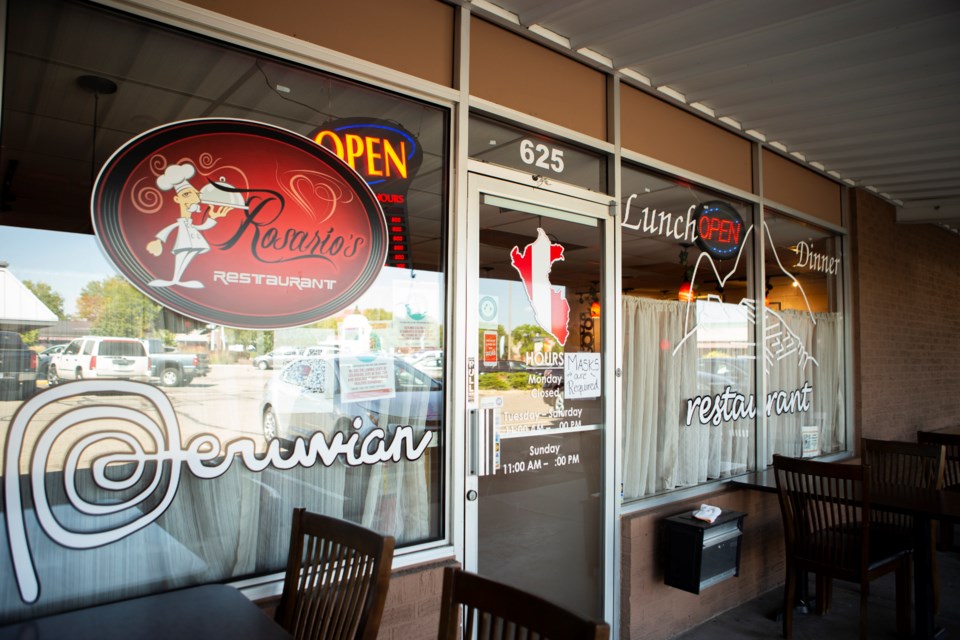Nestled in the corner of a shopping center located at Ken Pratt Boulevard and South Main Street, Rosario’s Peruvian Restaurant acts as a landmark for people who covet the restaurant for its tasty, authentic Peruvian offerings.
The majority of ingredients that make up the dishes on Rosario’s menu are sourced from Peru, according to Estefany Martinez, Rosario’s restaurant manager, and the Peruvian herbs, chiles and other foreign-born components contribute to making Rosario’s food a favorite among many in Longmont, she said.
By relying on frequent deliveries of products from Peru, Rosario’s Peruvian Restaurant has joined many other businesses in becoming frantic in the face of haphazard drop offs in recent years. The effects of worldwide supply chain issues are being felt by Longmont restaurants like Rosario’s as they struggle to survive without the regular influx of goods necessary for them to function.
For many local eateries, adopting ulterior methods of securing supplies is the means to maintaining a satisfactory customer experience – albeit an expensive one.
Last year, supply chains faced higher demands for operation while COVID-19 cases among workers, increased port congestion, extreme weather events and other disruptions made their operations more difficult, according to an article from Supply Chain Dive, a publication dedicated to supply chain management.
While supply chain issues have made deliveries from Peru to Rosario’s inconsistent, the restaurant has begun ordering larger quantities of Peruvian products at a time so they can have extra on hand when possible, Martinez said. However, this tactic doesn’t always work.
“Because of the shortages, there have been times when we haven’t been able to find ingredients and we’ve had to source them from other places that charge way more,” Martinez said. At several points, the restaurant has been forced to buy ingredients from Amazon, which charges almost double the amount the restaurant pays for the same ingredients coming from Peru, she said.
Although Rosario’s hasn’t had to make any permanent changes to the items on their menu, there are periods of time when some dishes aren’t available until the restaurant can secure the products to make them, Martinez said.
Instead, changes to the menu have come in the form of raised prices for some dishes, Martinez said – a result of paying larger prices for ingredients from other sources when they don’t come from Peru.
For Goodfella’s Diner, one of the biggest challenges stemming from supply chain issues is having to alter prices on their menu, according to Jef Norton, Goodfella’s restaurant manager.
“Pricing becomes very difficult at times when we’re not getting (products) through our normal wholesale suppliers and having to (purchase) on a retail level,” Norton said. “That hits (Goodfella’s) bottom line very hard.”
Since supply chain issues began, Goodfella’s hasn’t been able to rely on consistent deliveries of anything from paper products to fruits and vegetables, Norton said.
Similarly to Rosario’s, Goodfella’s has had to find alternative suppliers for the restaurant’s necessities, even if it means buying things they need from their local King Soopers – “which, of course, is an incredible added cost for us,” Norton said. Goodfella’s is intent on being able to maintain their customers’ satisfaction regardless of the challenges associated with the supply chain.
“We want to provide the Goodfella’s experience for everybody even if that means we have to scrounge for (supplies),” Norton said, or feel the aftermath of those items’ costs.
In providing the Goodfella’s experience for everybody, there are additional burdens on the restaurant to manage food costs, keep the prices on the menu fair for the product, keep the quality of products high and the portions generous as well, said Jeff Price, owner of Goodfella’s Diner.
“I think people are so quick to trim the fat and so they’ll go in and they’ll change the quality of their product or they’ll decrease the portions of the food,” Price said. “Increasing prices on the menu is inevitable just due to inflation and we have to do what we have to do to stay in business but, at the end of the day, we want to make sure that what we do have to offer as far as our service and our product is something that people value.”
According to Martinez, Rosario’s shares Goodfella’s priority for quality by not taking any shortcuts when it comes to the authenticity of their dishes. However, since 90% of its menu is made with Peruvian exports, disruptions to the supply chain “are definitely stressful and problematic for us,” Martinez said.
Seeing as experts expect supply chain issues to continue throughout 2022 and into the unforeseen future, according to an article from the New York Times, it seems restaurants’ struggle to secure supplies will also prevail indefinitely unless they can find a solution.
For Goodfella’s, the future of sourcing the restaurant’s products will require paying close attention to trends in the marketplace and potentially seeking local markets for food products they normally get from distributors.
“I think we have to watch the ebbs and flows with things and make adjustments on our end,” Price said. “We’ll always do what we have to do so if we’re able to get some products here locally, we’ll maybe have to pay a little bit more for it but, at the end of the day, I’d prefer to have that product available for our customers and have that consistency here at Goodfella’s.”
Rosario’s, on the other hand, doesn’t have the option to source Peruvian ingredients locally, according to Martinez, as a result of Colorado’s climate which makes them unable to grow and be produced here.
While Rosario’s continues taking it week-by-week and ordering Peruvian products online when necessary, the growing popularity of Peruvian food gives the staff at Rosario’s hope that, soon, the restaurant may have more sourcing opportunities locally, Martinez said.



